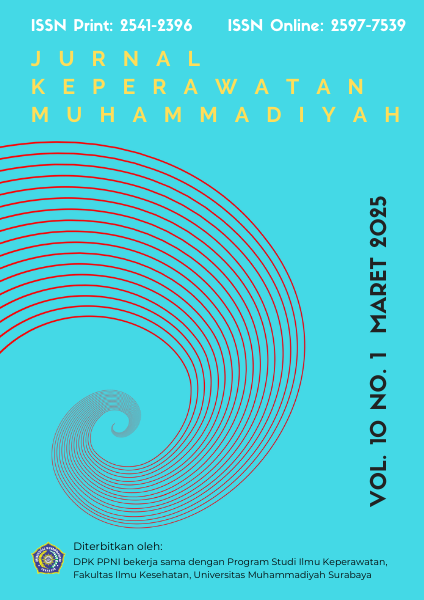Hubungan Perception Barriers Dengan Keaktifan Kunjungan Ibu Dalam Posyandu Balita
DOI:
https://doi.org/10.30651/jkm.v10i1.25012Keywords:
perception barrier, public health center, livelinessAbstract
The success of the posyandu program is very dependent on the active participation of the community, especially mothers with toddlers, but the reality on the ground is that the level of activity of mothers visiting posyandu is still often low. Various factors can influence this activity, one of which is the perceived barriers felt by the mother. Objective: The aim of this research is to analyze perception barriers with mothers' activeness in posyandu activities. Methods: This research design uses analytics with a cross-sectional approach. The population in this study were mothers who had participated in posyandu activities for at least 6 months. This research instrument uses a perception barriers questionnaire from the health belief model theory and documentation studies from the results of posyandu visits. Results: In this study the p-value obtained was 0.001. This shows that there is a relationship between perceived barriers and the activeness of mothers' visits to toddler posyandu. The main factors that influence perceptions of barriers include the mother's lack of understanding of the benefits of posyandu, lack of adequate posyandu facilities, and time constraints due to the mother's busy schedule. Conclusion: there is a significant relationship between perception barriers and the activeness of mothers' visits to toddler posyandu. The higher the perceived barriers, the lower the mother's active level of visitation.
References
Amalia, E., Syahrida, S., & Andriani, Y. (2019). FAKTOR MEMPENGARUHI KUNJUNGAN IBU MEMBAWA BALITA KE POSYANDU KELURAHAN TANJUNG PAUH TAHUN 2018. JURNAL KESEHATAN PERINTIS. Perintis’s Health Journal, 6(1), 60–67. https://doi.org/10.33653/JKP.V6I1.242
Amin, N. F., Garancang, S., Abunawas, ; Kamaluddin, Penulis, N., Nur, :, & Amin, F. (2023). Konsep Umum Populasi dan Sampel dalam Penelitian. PILAR, 14(1), 15–31. https://journal.unismuh.ac.id/index.php/pilar/article/view/10624
Andri, M., Sam, H., Akk, B., Kesehatan Masyarakat, F., Muhammadiyah Palu, U., & Promkes, B. (2023). Analisis Rendahnya Kunjungan Ibu yang Mempunyai Balita ke Posyandu di Kelurahan Pasangkayu Wilayah Kerja Puskesmas Pasangkayu 1 Kabupaten Mamuju Utara: Jurnal Kolaboratif Sains, 6(6), 544–551. https://doi.org/10.56338/JKS.V6I6.3721
Andriani, H., Liao, C. Y., & Kuo, H. W. (2016). Association of Maternal and Child Health Center (Posyandu) Availability with Child Weight Status in Indonesia: A National Study. International Journal of Environmental Research and Public Health, 13(3). https://doi.org/10.3390/IJERPH13030293
Anisca Dillyana, T., Nurmala, I., Promosi Kesehatan dan Ilmu Perilaku, D., Kesehatan Masyarakat, F., & Airlangga Surabaya, U. (2019). under CC BY-NC-SA License CORRELATION OF KNOWLEDGE, ATTITUDE AND MOTHER PERCEPTION WITH BASIC IMMUNIZATION STATUS IN WONOKUSUMO. 7(1), 68–78. https://doi.org/10.20473/jpk.V7.I1.2019.68-78
Ayue, heti ira. (n.d.). ASUHAN KEBIDANAN KOMUNITAS - Heti Ira Ayue, SST,M.Keb - Google Buku. Retrieved October 15, 2024, from https://books.google.co.id/books?hl=id&lr=&id=SPhiEAAAQBAJ&oi=fn d&pg=PA1&dq=
Baiq Nopia Karmila, 113421067. (2023). PENGARUH PELATIHAN KADER TERHADAP TINGKAT PENGETAHUAN SISTEM 5 (LIMA) MEJA POSYANDU DI DESA MARONG WILAYAH KERJA PUSKESMAS MUJUR KABUPATEN LOMBOK TENGAH.
Becker, Janz, M. H., Associate, R., & Becker Is Professor, M. H. (2015). The Health Belief Model: A Decade Later reprint requests to.
Dianti, Y. (2023). Panduan Pengelolaan Posyandu Bidang Kesehatan. Angewandte Chemie International Edition, 6(11), 951–952., 5–24. http://repo.iain-tulungagung.ac.id/5510/5/BAB 2.pdf
Dwi Ghunayanti Novianda, & Mochammad Bagus, Q. (2020). Faktor yang Berhubungan dengan Perilaku Ibu dalam Pemenuhan Imunisasi Dasar. Journal of Health Science and Prevention, 4(2), 125–133. https://doi.org/10.29080/JHSP.V4I2.402
Holt, A., Fahey, N., Cataltepe, D., Brochier, A., Stern, A., Mazanec, M., Courtemanche, J. W., Wilkie, T., Tan, K., Lyu, R., Alper, E., Fowler, J., Rhein, L., & Garg, A. (2024). Understanding barriers to well-child visit attendance among racial and ethnic minority parents. BMC Primary Care, 25(1), 1–7. https://doi.org/10.1186/S12875-024-02442- 0/TABLES/2
Kasumayanti, E., & Busri, I. N. (2017). FAKTOR-FAKTOR YANG MENYEBABKAN RENDAHNYA PERAN IBU BALITA KE POSYANDU DESA SUMBER DATAR WILAYAH KERJA PUSKESMAS SUNGAI
KERANJI TAHUN 2016. Jurnal Doppler, 1(2). http://journal.universitaspahlawan.ac.id/index.php/doppler/article/view/ 135
Kemenkes. (2018). Pedoman Umum Pengelolaan Posyandu.
Kunjungan, E., Ke, B., Di, P., Pandemi, M., Di, C.-19, Totikum, P., Kepulauan, K. B., Lahmadi, L., Multazam, A. M., & Kurnaesih, E. (2021). Evaluasi Kunjungan Balita Ke Posyandu Di Masa Pandemi COVID-19 Di Puskesmas Totikum Kab. Banggai Kepulauan. Journal of Muslim Community Health, 2(3), 138–153. https://doi.org/10.52103/JMCH.V2I3.551
Notoatmodjo. (2014). Metodologi Penelitian Kesehatan. Rineka Cipta. Otieno, P., Kibe, P. M., Elmi, M., Kisiangani, I., Bakibinga, P., Mohamed, S.
F., Kisia, L., Afeich, N., Nyaga, A. A., Njoroge, N., Noor, R., & Ziraba,
A. K. (2020). Persistent barriers to the use of maternal, newborn and child health services in Garissa sub-county, Kenya: A qualitative study. BMC Pregnancy and Childbirth, 20(1), 1–12. https://doi.org/10.1186/S12884-020-02955-3/TABLES/2
Putri, B. L. (2019). Hubungan Keaktifan Kunjungan Ke Posyandu Dengan Kualitas Hidup Lansia Di Ngudi Waras Sapen Umbulmartani Ngemplak Sleman. http://lib.unisayogya.ac.id
Radhiah, S., Ayunda, C. R., & Hermiyanty, H. (2021). Analisis Rendahnya Keaktifan Kunjungan Ibu Balita Ke Posyandu Tompo Kecamatan Taopa Kabupaten Parigi Moutong. Preventif : Jurnal Kesehatan Masyarakat, 12(1), 149–160. https://doi.org/10.22487/preventif.v12i1.289
Rahmi, N., Andika, F., & Ilmu Kesehatan, F. (2021). PEMANFAATAN POSYANDU UNTUK PENINGKATAN KESEHATAN BAGI BAYI DAN BALITA DI WILAYAH KERJA PUSKESMAS PEUKAN BADA KABUPATEN ACEH BESAR. JURNAL PENGABDIAN KEPADA MASYARAKAT BIDANG KESEHATAN, 3(1), 51–55.https://jurnal.uui.ac.id/index.php/jpkmk/article/view/1465
Rosenstock, I. M. (1966). Why people use health services. The Milbank Memorial Fund Quarterly, 44(3). https://doi.org/10.2307/3348967
Sholihah, N., & Kusumadewi, S. (2015). SISTEM INFORMASI POSYANDU KESEHATAN IBU DAN ANAK.
Susilowati, N., Sapartinah, T., Widyastuti, E., Kebidanan, J., & Kemenkes Semarang, P. (2021). FAKTOR YANG MEMPENGARUHI IBU DALAM KUNJUNGAN IMUNISASI PADA MASA PANDEMI COVID-19 DALAM PERSPEKTIF HEALTH BELIEF MODEL (HBM). Midwifery Care Journal, 2(3), 82–87. https://doi.org/10.31983/MICAJO.V2I3.7492
Ummah, F., Kusdiyana, A., & Saputra, M. G. (2021). PEMBERDAYAAN KADER POSYANDU DALAM PENCATATAN DAN PELAPORAN BERBASIS WEBSITE. Jurnal Abdimasmuhla, 2(1). https://www.jurnal.umla.ac.id/index.php/JA/article/view/268
Widyaningsih, T. S., Windyastuti, W., & Tamrin, T. (2020). Peran Kader Dalam Memotivasi Ibu Balita Yang Berkunjung Ke Posyandu. JKEP, 5(1), 1–12. https://doi.org/10.32668/JKEP.V5I1.225
Downloads
Published
Issue
Section
License
Copyright (c) 2025 Apriyani Hastuti, Roidah Hadis Widiya Wati, Ardhiles Wahyu Kurniawan

This work is licensed under a Creative Commons Attribution-ShareAlike 4.0 International License.
- Penulis tetap memegang hak atas karyanya dan memberikan hak publikasi pertama kepada jurnal ini yang secara simultan karya tersebut dilisensikan di bawah:Â Creative Commons Attribution-ShareAlike 4.0 International (CC BY-SA 4.0)













